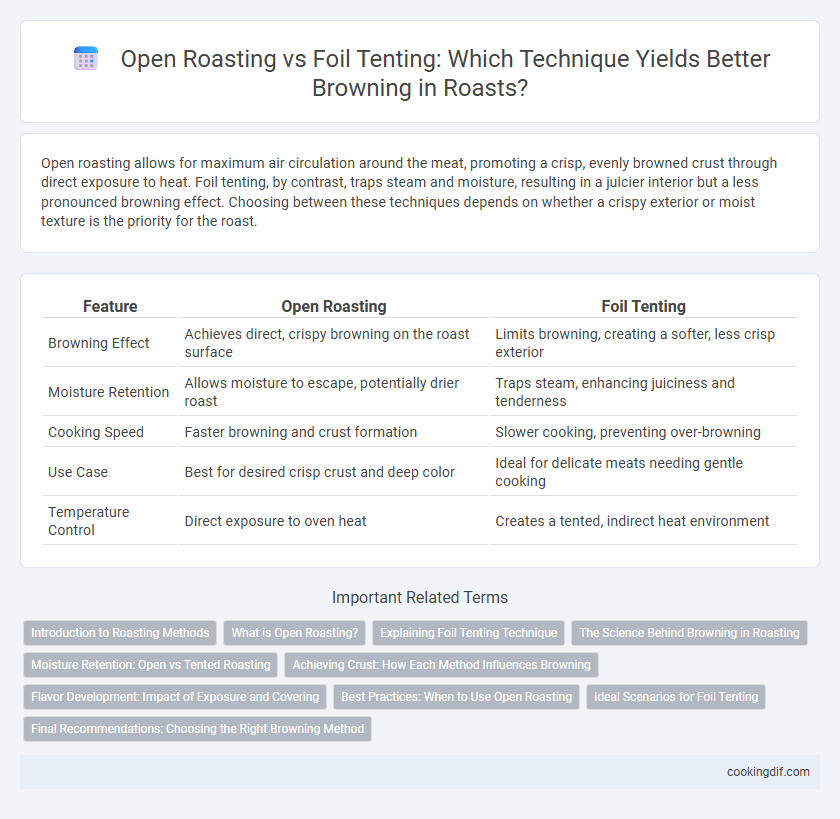Open roasting allows for maximum air circulation around the meat, promoting a crisp, evenly browned crust through direct exposure to heat. Foil tenting, by contrast, traps steam and moisture, resulting in a juicier interior but a less pronounced browning effect. Choosing between these techniques depends on whether a crispy exterior or moist texture is the priority for the roast.
Table of Comparison
| Feature | Open Roasting | Foil Tenting |
|---|---|---|
| Browning Effect | Achieves direct, crispy browning on the roast surface | Limits browning, creating a softer, less crisp exterior |
| Moisture Retention | Allows moisture to escape, potentially drier roast | Traps steam, enhancing juiciness and tenderness |
| Cooking Speed | Faster browning and crust formation | Slower cooking, preventing over-browning |
| Use Case | Best for desired crisp crust and deep color | Ideal for delicate meats needing gentle cooking |
| Temperature Control | Direct exposure to oven heat | Creates a tented, indirect heat environment |
Introduction to Roasting Methods
Open roasting exposes food directly to hot air, promoting even browning and a crisp exterior through Maillard reactions, ideal for achieving a caramelized crust. Foil tenting, typically used in the latter stages of roasting, slows heat exposure and reduces moisture loss, resulting in juicier meat while still maintaining some browning. Understanding these methods allows cooks to balance texture and moisture retention for optimal roast results.
What is Open Roasting?
Open roasting is a cooking method where food is exposed directly to heat without any covering, allowing moisture to escape and promoting a crisp, browned exterior. This technique enhances the Maillard reaction, resulting in deep, complex flavors and a desirable texture. It contrasts with foil tenting, which traps steam and retains moisture but may reduce the intensity of browning on meats or vegetables.
Explaining Foil Tenting Technique
Foil tenting is a cooking technique where aluminum foil is loosely draped over a roast to shield the surface from direct heat, preventing over-browning while allowing the interior to cook evenly. This method helps maintain moisture and tenderness by trapping steam, resulting in a juicier roast compared to open roasting. Foil tenting is especially effective for larger cuts that require longer cooking times, balancing a well-browned crust with a succulent interior.
The Science Behind Browning in Roasting
Open roasting exposes meat directly to dry heat, promoting the Maillard reaction by enabling rapid surface dehydration and increased temperature, which forms complex flavor compounds and a rich brown crust. Foil tenting traps moisture and reduces surface drying, slowing the Maillard reaction and resulting in less pronounced browning but preserving juiciness. Understanding the balance between heat exposure and moisture control is essential for optimizing crust development and internal tenderness during roasting.
Moisture Retention: Open vs Tented Roasting
Open roasting exposes meat directly to dry heat, promoting a crisp, well-browned exterior but causing significant moisture loss. Foil tenting traps steam around the roast, enhancing moisture retention and resulting in juicier meat with a less pronounced crust. Choosing between open roasting and foil tenting depends on balancing desired browning intensity against the priority of preserving internal juiciness.
Achieving Crust: How Each Method Influences Browning
Open roasting exposes the meat directly to hot air, promoting Maillard reaction and caramelization that create a deeply browned, flavorful crust. Foil tenting traps moisture and reduces exposure to dry heat, which slows browning but helps retain juiciness and tenderness. Choosing between open roasting and foil tenting depends on balancing the desire for a crispy crust with the need to preserve moisture in the final roast.
Flavor Development: Impact of Exposure and Covering
Open roasting exposes meat directly to radiant heat, promoting Maillard reactions that develop complex, caramelized flavors and a crisp browned crust. Foil tenting traps steam and heat, creating a moist environment that limits surface browning but enhances juiciness and tender texture. Balancing exposure and covering influences the depth of flavor development by controlling dryness and caramelization during the roasting process.
Best Practices: When to Use Open Roasting
Open roasting is ideal for achieving deep, even browning on meats with higher fat content or thicker cuts, as the direct exposure to heat promotes Maillard reaction efficiently. Best practices suggest using open roasting when a crispy exterior and caramelized flavor are desired, such as with whole chickens or pork shoulders. This method allows excess moisture to evaporate, preventing steaming and ensuring a richly browned crust.
Ideal Scenarios for Foil Tenting
Foil tenting is ideal for roasting larger cuts of meat like prime rib or whole poultry, where maintaining moisture and preventing excessive browning are critical. This method slows down the surface cooking, allowing the interior to cook evenly without the crust becoming too dark or burnt. Foil tenting is especially beneficial during the resting phase to retain heat and redistribute juices for optimal tenderness and flavor.
Final Recommendations: Choosing the Right Browning Method
Open roasting allows natural Maillard reaction browning, yielding a crisp, flavorful crust with enhanced aroma. Foil tenting retains moisture, creating a juicier interior but softer crust texture. Select open roasting for maximum caramelization and robust flavor, while foil tenting suits dishes requiring tenderness and moisture preservation.
Open Roasting vs Foil Tenting for Browning Infographic

 cookingdif.com
cookingdif.com